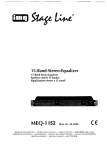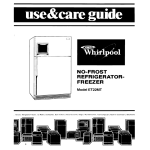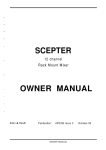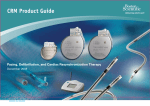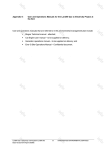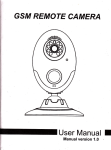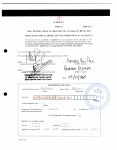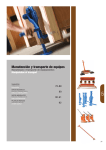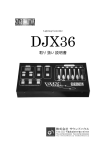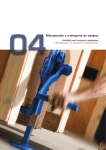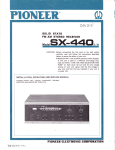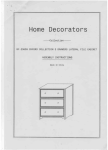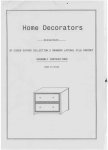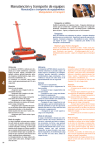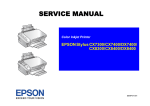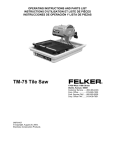Download FostexB16 - Preservation Sound
Transcript
FOSTD( PROFESSIONAL M U LTITRACK
USER PRICE SCHEDULE
June 15, 1984
7*- 7a
€
8.16
rlttr
8.16D
(Standard Model)
16-channel recorder/reproducer with Vz" tape transport.
Belt drive capstan motor; two direct drive reel motors;
full I.C. logic; 15 ips with +
157o variable speed
operation; video interlock ready; intergral Dolby C noise
reduction; l2-point LED bar graph
-.r.rt"tSr#[tb'
(Shown in optional floor console)
Same features as the standard model, but with
direct
motor. Key specifications
for both models: -10 dBV (0.3V) inputs and outputs;
0 dB referenced to 320 nWb/m of tape flux; S/N ratio
80 dB, weighted with Dolby C NR; crosstalk
-55 dB
70 dB
t O"z$UTOO.OOat l kHz; erasure
drive phase locked loop capstan
-
Modification for 7/z ips operation: Call for quote.
",
Modification for 772 or 30 ips operation: Call for quote.
*All prices are suggested retail and
subject to change without notice.
Dolby is a registered trademark of Dolby Labs, Inc.
FOstO(
PROFESSIONAL
MULTITRACK
are
B.16DM
(lndependent Monitor Model)
The b-16D with the following additions: a third head
for dape reproduce; a7" rack panel with 16 independent
channels of reproduce and Dolby decode; a remote control
unit. This remote units lets you select any combination
of 16-track reproduce which can then be monitored via
the headphone jack with independent level control, or
via the line out jack. There's a meter for fast alignment
and a switching facility for source/tape comparisons
lvithout touching the recorder.
$9600.00
B.16 OPTIONS
Model
8090
AL.16
Price
Remote Control udt with all transport cornmand functions,
16 track select for record ready, plus a cue switch for setting
the end of a section to repeat (loop).
$ 450.00
Auto Locator
has all above features and functions, plus a 9-position key
pad. The recorder can be programmed to repeat (loop) between any two
positions.
$1200.00
8050
Remote foot switch for punching in and out.
$
15,00
9012
10t/2" Metal. reel with Fostex logo.
20.00
9905
Rack mount adaptors.
$
$
9080
Floor Console (requires rack mount adaptors)
s
360.00
9042
Meter mounting kit contains rack adaptors; blaok paoel; interface cable.
s
100.00
9200
l/u
$
$
70.00
9201
" alignment tape
lz" speed/ fluttet taPe
1090
Record/Reproduce card
$
130.00
1091
Extender card
N/A
Service manual
N/A
t/2" 8-ttack
uses
$
$
playback head, mounted in floDt of the 16-track head stack;
the recorde!'s reproduce electronics.
60.00
60.00
30.00
s8.00
$1000.00
Other Fostex Options
6301s
5030s
2050s
INTERFACE with studio/commercial equipment is as
simple as patching. Model 5030 converts -10 dB, high
impedance, unbalanced line with pin jack connector to t 4
dBm, 600 Ohms, balanced line with XLR-type connector, or
vice-versa. 8 channels per unit. Two unirs.
$1190.00
MONITOR package includes two 8-channel /stereo line
mixers (gain and pan controls for each chaonel) and a pair of selfpowered personal monitors.
An
package. Four units.
FOstO(
PROFESSIONAL MULTITRACK
FOSTEX CORPORATION OF
AMERICA
incredibly flexible monitor
$698.00
Look for these and other useful audio tools at your Fostex
Professional Multitrack Dealer. Chances are he's also a Fostex
ko Audio Dealer. In which case, be sure to find out about Fostex
microphones, headphones and'peaker*.
Be especially sure to audition the new near-field point source
monitors. They incorporate Fostex RP technology, which has
earned over 20 international patents to date.
15431 Blackburn Avenue, Norwalk,
*All pdces ale suggested retail
and ate subiecl to change wilhout notice.
cA 90650 (2131921-'1112
FOSTEX B. 1 6
TEST REPORT
REPRINTED WITH PERMISSION OF
MODERN RECORDING & MUSIC
NOVEMBER, 1984
FOSTEX CORPORATION OF AMERICA 1543t Blackburn Avenue, Norwalk, cA 90650
(213) 921-1112
len feldmon
Fostex B-'16 ,16-Trock
Recorder/Reproducer
General Description:
The Fostex 8-16 is, first
and foremost, a remarkable engineering achievement.
Being able to lay down 16 independent tracks on halfinch tape is no small feat, and that's what the B-16 lets
you do-easily and effectively. For multitrack live
recording dates in the field, or even for small-studio
work, the 8-16 may well be the answer to a recording
engineer's dream. With it, no more sub-mixes are
needed; you can do a full 16-track live recordingwhere
formerly you had to settle for 8 tracks.
To be sure, cramming 16 tracks on half-inch tape
means that each track is about as wide as the narrow
tracks you find on a home cassette deck. You'd think,
therefore, that such important parameters as
frequency response, signal-to-noise ratio, headroom,
and distortion would suffer. Not so. thanks to such
innovations as Dolby C, asuperb, proven half-inch tape
transport, an unusually precise head configuration
and excellent record/playback electronics. Many of
the features demanded of a professional recorder are
there. including punch-in recording. The one thing
lhal i.s not there is tape monitoring, since the record
head is also the reproduce head. With the excellent
LED meters available for each channeJ. however, you
probably won't miss the third head in actual
production work. With the 8-16 calibrated for fixed
input and output levels (there are no front panbl level
controls-only calibration controls for initial adjustment), you will, of course, need a 16-in/out console of
some kind to go with the 8-16. A remote control
(tr'ostex Model 8090) can be interfaced with the 8-16
via a remote control jack on the rear panel.
The 16-channel LED Bar Graph meter on the front
panel of the 8-16 can be lifted out and installed at a
remote location such as a mixing console or video
switcher. An optional meter mounting kit is available
for that purpose.
54
Control Layout
The reel holders of the 8-16 are
equipped with permanent NAB hub adapters. The
pinch roller, head assembly, and other elements in the
simple tape threading path are fairly conventional,
and there is a tape sensor which is activated to put the
transport in the stop mode if tape breaks or at end-oftape. A head shield gate in front of the head assembly
can be manually raised or lowered.
The lower right section of the front panel contains a
dual concentric pitch control knob. The outer knob is
used for large amounts ofpitch change, the innerknob
for trimming pitch to exact requirements. A pitch
control switch nearby is used to bypass the pitch
control when precise 15 ips speed is desired. A fivedigit counter display nearby shows hour, minute, and
seconds of tape travel. For tape positions below the
zero point, a minus sign (-) is displayed in front ofthe
hour numeral. A reset button for the counter islocated
adjacent to it. Transport touch-buttons include pr-Ay,
FAST FORWARD, FAST REWIND, STOP, RECORD ANd ZERO
RETURN. Touehing this last-named pushbutton will
cause the transport to rewind tape to precisely the zero
point on the counter,
Sixteen small pushbuttons spread across much of
the width of the front panel arepositioned abovethe 16
bar-graph LED meters. These pushbuttons determine
whether recording can begin on a given track. If the
tapd is not in motion, depressinga specific track button
places that track in the nEcoRD READY mode, and the
LED above that track's meter will flash on and off. If
only the main REcoRD button (near the transport
control buttons) is depressed, the dB meter indications
and signals from the output jack will change from
"tape out" to "input monitor" for those channels whose
record track buttons are depressed, and if the rNpUT
MoNITORswitrh is setto Individual, the Input Monitor
LEDwill begin toflash. This mode iscancelled by again
MOOERN RECOROING & MUSIC
(A,
lBdB/[ L- 3.gdE R- Z.8dB
?Z.EkHz
lB)
tEdE/[ L- 3 tdE R- 2 4dB
40Hz
Figure 1. Frcquency response, record/play, without
Dolby nolse reduction. Cursor shows high lrequency
cutoll (A) and bass cutoll (B).
depressing the record button. If the record and play
buttons are depressed together, recording begins, the
Record Track LED stops flashing and remains lit
continuously, and the Record LED turns on.
If the tape is rolling in the pLAy mode, depressing a
record track button readies the track for recording. If
the tape is rolling in the record-ready mode, the record
LED near the record button will flash and subsequent
depression of a record track button will immediately
cause that track to enter the record mode. It is this
procedure which is used for punch-in recording of any
of the 16 available tracks. An input monitor delector
switch, ifset to the ellposition, will cause all channels
to read input monitor levels and a green LED nearby .
will be lit. If the switch issetto rNDrvrDue.l, individual
channels can monitor inputsignals. Acue lever located
beneath the head block assembly, if pushed forward
towards the head, makes the tape lifters retract,
allowing tape cueingduring FAST FORWARDoT REWIND
accepts a Fostex Model 8050 footswitch, a meter jack
(for use when the meter assembly is remotely located),
and the noise reduction switch. ln the INT position of
this switch, the built-in Dolby C circuitry is active.
When the switch is set to EXTERNAL, the Dolby C
system is bypassed and an external noise reduction
system can be parched into the system,
While the control layout as described mayseem a bit
complicated at first, we found that if we followed the
instructions step-by-step, the full versatility of the B16 was easily accessed. After a few minutes ofworking
with the machine, we were quickly and efficiently
performing such standard functions as ordinary
multitrack recording, overdubbing, punch-in/punchout recording onto given tracks, and, of course,
playback. While we did not work with an associated
console during our bench tests, it was clear that the
addition of a 16-track console would in no way make
use of the machine any more difficult or complex.
modes.
The rear panel contains the required input and
output jacks for each channel, the remote control
connector jack, a remote punch-in/punch-outjack that
IBdB/I L-
l
SdB R- 2 4dE lB
SkHr
Test Results:
Results of our laboratory measure-
ments are summarized in the VITAL STATISTICS
(8)
l0dE/! L- 2.6d8 R- Z EdE
48Hz
Figure 2. Frequency response, record/play, with Dolby
noise reduction. Cursor is set lo show hlgh lrequency
culoll (A) and bass cutott point (B).
NOVEMBER 1984
55
n3
LI5I
L
?.0:t,
3
3
,l
I
I
.1
.1
,03
.03
l8dB/t
L-36 8d8
+i8dB
(s)
18dB/B L-33 7d8
+l tdE
Figure 3, Third-order distortion, record/play, vs.
record level, wiih Dolby (A) and withoul Dolby (8).
chart found at the end of this report. In order to be fair
and yet thorough, we elect€d to use a pair of adjacent
tracks for tests involving crosstalk between channels.
By the same token, we felt that it would be unfair to
measure such parameters as frequency response and
signal-to-noise using the outermost tracks, and so for
those measurements we selected a pair of tracks near
the center of the half-inch wide tape. We later
discovered that had we used the outer tracks, results
would have been essentially the same; quite an
achievement when you are trying to accommodate 16
tracks on half-inch tape!
RECORD/PLAY frequency response, without Dolby()
turned on, was flat (within 3 dB) from 40 Hz to 22.0
kHz at a -20 dB record level (relative to 320 nWb/m, or
0 dB on the LED metering system). Fr.gzrre I shows the
graphic results obtained at 0 dB record level (upper
curve) and at 20 dB (lower curve) over the range of
20 Hz to 40 kHZ Figures 14 and, 18 are identical,
except that the dotted line "cursor" has been moved to
the high-frequency cut-off point in -F dgzre 1.4, while in
Figure 1B iL has been positioned to the low-frequency
-3 dB point (or, as close to that attenuation as possible);
in this case 40 Hz. The double vertical lines in all of
l'l5
FT L-49 8d8
lEdE/n
these frequency graphs represent (reading from left to
right) frequencies of 100 Hz, l kHz and 10 kHz.
Vertical scale in ihis and other figures of this type is
10 dB per division.
A second set of frequency response measurements
was made with the Dolby C circuitry turned on.
Results are shown in Figure 2. This time, response
extended to slightly above 18.5 kHz and to slightly
belorv 40 Hz at the bass end. Results were still better
than the minimum specified by Fostex. Again, the
dotted line "cursor" in Figures 2A and gB has been
positioned to show the closest frequencies to the -3 dB
roll-off points at the bass and treble ends of the sweep.
Figure 3 shows a plot of third-order harmonic
distortion as a function of recording input levels.
Results shown in Figure 3.4 are with Dolby C active;
while those in Figure 38 arc for the Dolby-Off
condition. The double vertical line represents 0 dB
reference level, while each diyision horizontally
represents an increase (or decrease) of 5 dB with
respect to that level. Our test equipment generally
starts plotting at around +10 or +11 dB above the
reference level and. as you can see lrom the results,
even at those recording levels, distortion had not
|l5
H! L-68
ZdB
iBdE/n
0
dB
-20
-40
60
80
-100
(A lEdB/n L-6Z.?dB
8.06kHz
.,, IEdE/! L-84
ZdB
8.00kHz
Figure 4. Signal-to-noise analysis, without Dolby,
measured withoul weighlang curve (A) and wlth
CCIR/ARM weighting (B).
56
MODERN RECORDING & MUSIC
IIS
FT L-E?.7d8
ll5
tSdB/n
SIGML
TOO LOI{
0
dB
-20
-40
-60
-80
-100
,^, l0dB/ll L-92.3d8
-100
,,, lodE/ll
8. 60kHz
Figure 5. Signal-to-noise analysis measured with
Dolby C, unweighled {A). When weighting curye
reached the 3 percent maximum which we use as a
reference for maximum permissible recording levels.
We estimated, therefore, that headroom would be
about +12 dB, with or without Dolby on, and separate
measurements using an ordinary distortion analyzer
confirmed that estimate. At nominal 0 dB recording
level, third-order distortion measured only 0.24
L-g4.8dB
8.00kHz
(CCIR/ARM) was added, noise uyas too low lor lest
inslrumenl to read,
better than we would have ever suspected. Effective
dynamic range, usingthe built in Dolby C, is so high, in
fact, that itwould not be unreasonble to use thisdeckas
a mastering system for a recording that was
ultimately intended for transfer to Compact Disc
format!
Wow-and-flutter was also analyzed using our Sound
Technology 1500A Audio Analyzer, and, as displayed
percent with Dolby C and 0.25 percent without Dolby.
These results are far bett€r than the 1 percentclaimed
by Fostex. The tape used, incidentally, was Ampex, a
reel of which was supplied with our test sample.
measured only 0.044 percent, while the peak wow
component, at 10 Hz, measured 0.045 percent. Again,
Several analyses of signal-to-noise were made, both
the sample did much better than the minimum
in Figure 6, the WRMS value of wow and flutter
with and without Dolby noise reduction turped on. As
shown in Figure .1, S/N without Dolby and without a
specification published by Fostex. Channel separation,
plotted in Figure 7, was parlicularly good at the high
frequency end of the spectrum, where we would have
weighting curve measured 49.8 dB. Adding a
CCIVARM weighting system, thisfigure improved to
60.2 dB. For the results shown in Fi,gure 5, Dolby C
noise reduction was activated. This time. the
expected
unweighted S/N measured a very high 82.? dB. When
we added CCIR/ARM weighting, the message seen
above the graph of Figure 58 tglls trhe story; the noise
level was simply too low for our test equipment to
measure! In short, the signal-to-noise ratio obtainable
with Dolby C added to these very narrow tracks isalot
FL
l,l! LE
8447
it
to fall off. As shown in the diagram,
separation at 1.0 kHz measured 51.2 dB; a bit shortof
the 55 dB claimed, but remember that we measured
separation between adjacent tracks. That is a "worst
case" condition, and separation between more widely
separated tracks is much higher; as high as 60 dB, in
fact. What did surprise us somewhat was the rapid
decrease in separation at the extreme low-frequency
end of the audio spectrum. At 100 Hz, for example,
F58. l0U
CS
.08
.06
g
.04
.o2
0
.Bl[y,ln L+6.845X
10,
E
Hz
Figure 6, Wow-and-tluller anrlysb ol Fostex B-10.
tEd[/D L-St.zdB
E0kHz
Figure 7. Channel separation v3. trequency ot Foslox
B-l6i Dolby C is
NOVEMEER 1984
t,
otl.
s7
but we suspect that having to come up with two
-separation between the two adjacent channels we
tested had decreased to just over 30 dB. Happily, that
will not effeet stereo imaging to any significant degree,
perfectly aligned 16-track heads (one for record, the
other for playback) and nearly double the amount of
electronic amplification circuitry (not to mention a
double Dolby C requirement) would, undoubtedly
have added considerably to the cost of what is now an
extremely reasonably priced machine.
(Editor's note: the Fostex B-16DM does have a full
16-track playback head and 16 additional channels
of Dolby C for full monitoring capability, and in-
since as everyone knows, ultra low frequency
components are essentially non-directional during
reproduction. Of course, this also means that if you
want to put an isolation track onto tape, it would be
best to leave the adjacent track or tracks blank.
Not€ elso that our measurements' ere made only
with Dolby C off. Thus, the measured 57.2 dB zllkHz
would be improved by 19.6 dB, handily exceeding
Fostcx's-S5 dB Dolby-On spec.
cluding remote control and other features. The
price is $9.600.)
Even if you have been accustomed to being able to
tape monitor every track in a multitrack machine, the
ability to monitor previously recorded tracks while
,
Comments: Our first impression
of this remarkatrle
tape deck remains unaltered after bench testing. The
8-16 is, we would think, exactly what many
dubbing tracks that are currently being recorded
offsets the disadvantage of full tape monitoring
facilties. And, as we said at the outset, those 16 LED
professional music groups are looking for. It is also
what many small recording studios who have to do
remotes and are limited in terms of space inside their
vans or trucks have probably had right at the top of
their "wish lists." Tape motion during fast winds was
very smooth and quieter than on most professional
decks we tested of late. If you use the zERo RETURN
REwIND mode, the system quickly finds the 0:00:0 point
unerringly. Sometimes that means a slight overshoot,
but that's followed by a quick return to the correct
point, Though the owner's mdnual doesnt mention it,
we soon discovered that if you press znRo RETURN and
follow that up with a press of the pLAy button, the
system "remembers" your instructions and goes right
into the play mode after the zero point has been
reached. Punch-in recording resuh€d in absolutely no
audible "glitrhes" during playback, and overdubbing
a lot ofthe doubts otherwise
associated with this type of non-monitoring recording.
Fostex obviously has studied and fully understandsthe
needs of its potential customers-the music industry
and the small recording studio owners-and has come
up with a product that seems m fili their r€quir€ments
bar-graph meters remove
perfectly.
8-16 options include a full remote control with all
transport functions at $450;an auto locator with all the
features ofthe remote control plus a 9-position key pad
permitting the recorder to be looped between any two
positions at $1,200; dual 8-channel interfaces convert
the -10 dB, high impedance unbalanced lines to +4
dBm, 600 ohm balanced lines .vlith XLR-type
connectors, the spt being $1,190. As a special feature,
Fostex has available ahalf-inch 8-track playback head.
that can be mounted in frontofthe 16-track head stack,
or "sync" recording was easily and perfectly
accomplished from any track to any other track or
tracks by the versatile track touch buttons used in
combination with the monitor switch and record
using the recorder's reproduce electronics. This
permits half-inch 8-traek formatted tapes to be played
on the B-16; the price is $1,000. This mustbe requested
buttons.
Of course, tap€ monitoring would have been nice,
at the time of ordering your 8-16.
FOSTEX MODEL 8-16 TAPE BECOROER: Vltal Slatlstlcs
A1{UFACIURER'S CtAt
SPECTFTCAT|Ot{:
l5lpr'
T.p. Sp.!d
n.d skr
'10 %
llsmbtr ol ?tackr
l{unbat ol Chrrnrl.
Fr.qusEy F..ponr
lnput lavtl
t6
Conllm.d
13
Conllrm€d
40 Hz to 18 kHz
-r0 dBv (0.3v)
40 Hz.l8.5 kHz, 40 Hr-22 khr, no Dolby
Outsul
(3 dB)
Larl
Op.rrllng l,wd, 0 dB
S/ / 1.3% THD (r/Dolby C)
Unrclghtld
W.lehtrd
THD
d 0 da (l
kHr)
L.!.l lor 3% THO
lvou{nd-Flgll.t
crottt.lk (t lHz-l{o
Dotby)
clllrLlt (t kHr*Dotby on)
'
lnch
UN&M MEASUREO
Conllmrd
Erxur. (l lHr)
Porlr Faqulr.lnrntr
Dlmrndont(WrHrD, ln)
Yu.lghl.
-1O
dAY (0.3V)
320
nwb/m
l0% lnch
Conlllmad
Conllrmod
Conllrmsd
Conll]msd
60 da
80 dB
827 dB {CC|B/AnM)
1.0%
0.25v0
+10 dB
0,06%
+12 dB
0.Oila%
51.2 dB
S99
11.t8
55 dB
70 dB
170 W
(3nl HD)
S.s Tcrt
12 dg
171ht17t91.
87
Tert
lbr.
Conllrmed
Conll]m6d
Contlrmcd
Prlc!: 38,800.00
i
-
i 'Flrad md vlrllbl..p€.d nod.r rvlllabl!. ln vlrllble
-
mod€, !15%
a
-+MODERN RECOROING & M usrc
16-Track Flexibility
possibly make.
More than any other factor, the multitrack
16-Track Reality
The B-16D was made possible by innovalive advances in head technology, record/
reproduce electronics, the incorporation
tape machine determines the actual recording flexibility of an audio production facility.
There are logarithmic progressions in flexibility as you move from 4{rack to 8-track to
16-track machines.
The freedom to experiment expands considerably when you have open tracks.
of Dolby C Noise Reduction and the proven
design principles of the half-inch tape
transport.
Signal quality and overall pertormance
characteristics are far beyond the practi"
cal limitations of most commercial media.
So regardless of your application, look to
the B-16D to increase your audio production efficiency and flexibility in the most
economical way possible.
The Transport
16'Track Efficiency
The acceptance of the smaller, more eflicient machine in many related fields-from
aerospace and automotive to computer and
video-suggests a basic trend to reduce
size and increase efficiency.
That's the reason the B-16D exists. lt's the
newer, better way to increase your audio
production efticiency.
It fits nicely into the cramped coniines of
a remote truck. Live multitrack recording
dates have suddenly become straighl
forward.
Extra dollars can be stretched from tight
production budgets when you have your
own in-house audio sweetening facility.
The B-16D comes pre-wired for video inter-
lock synchronizers, and it locks up fast in
the chase mode.
The operational logic is so well defined,
and the internal switching is so convenient,
you don't need someone else to help work
the recorder. The B-16D is lhe ideal recorder
for the serious musician, songwriter or
producer who prelers to work alone.
16-Track Economy
Consider all the key money issues: initial
investment, options and system interface,
operational costs (tape), maintenance and
resale.
Your Fostex Professional L4ultitrack Dealer
can show you in black and white, point by
point, why the B-16D is the smartest, mosl
economical '16{rack investment you can
The rigorous demands of multitrack recording-the constant back and forth use of the
same piece of tape-can strain the tape
if
proper tension control
is nol
main-
tained.
The design of the B-16D ensures constant
tension in every mode. Two sensor arms
constantly monitor motion and govern the
two direct drive reel motors ior smooth,
positive control. Full lC logic.
The latest high torque motors and solenoids
all consume less current. so a more compact power unit ls used for less heat and
less weight.
Motion and tension sensing, servo control,
tachometer and audio switching all interface to a central LSl. This dedicated chip is
the intelligence behind the B-16D's tape
handling prowess.
ln the EDIT mode, you have servo control
overthe reels, so you can rock one-handed
to find a precise cue. This is especially useful if you have to get rid of a kick drum beat
or a hiccup just before the vocal.
Other editing conveniences include a manual cue lever to deleat the tape lifters during
fast wind modes, and a simple push-push
retractable hum shield gives excellent
working access to the heads.
The real time counter is a digital display in
hours, minutes and seconds, and provides
both plus and minus times (elative to zero
set. Elapsed time is logged in both the play
and fast wind modes, and search-to-zero
can be accomplished from either direction.
The Eleclronics
The precision head assembly is a breakthrough in design that has made the unique
format of the B-16D possible. Special high
density permalloy is used, with a core
design which reduces contour effects to
less than 1dB.
:
.
li
FREOUENCY RESPONSE
i/'-_
/.l./t',:
. vl/..
,/,/,/
..
| /l /
i b,/ /-
.CROSSTALK
Adjacent channel crosstalk is only 55dB
at 1kHz, which easily matches the performance of wider format machines. Heads
are block mounted lor accessible azimuth
adjustment.
Dolby C Noise Fleduction circuits are built.
in, and encode/decode switching is auto-
matic. The Dolby system operates over a
constantly changing band of irequencies.
ln the presence of music, ihe band slides
up out to lhe way of the music, so noise at
Reproducer to Use ll2incl
I
a section with a ZERO reset button; mark
the end wilh the CUE button, even in last
wind modes.
The B-16D will now cycle between these
two points until instructed
10 stop.
Selecting
any lransport bulton will automatically
defeat the REPEAT mode.
frequencies above the music is reduced
without affecting the music itself. Low frequencies are not processed by the Dolby
circuits. thus avoiding the problem of norse
modulalion. An additional benefit of the
osignal to noise ratio
iiff,il,l
'r\tr*
Here is a 16-lrack recorder where everything is where you would expect for fast and
smooth operation. Metering, Monitoring,
record select status are obviously and easily
cross-referenced, so you don't have io give
your undivided attention to the recording
process.
Which gives you mqre time to concentrate
on the material you're recording.
For extra flexibility, the meter panel
is
removable. You can place it next to the audio console, video switcher, or mount it in
)
our "cab over" version of the floor standing
console.
lndependent Tape Monitor
(Model B-16M)
This particular modelwas designed specitically for the demands of live recordingtypically multitrack video shoots and remote location recording.
It is contigured with the direct drive PLL
capstan motor, independenl reproduce
head, an 7" rack height unit with 16 independenl channels ol reproduce/decode
and a remoie control unit.
This remote unit lets you select any combination of 16-track reproduce which you can
Dolby C system is a circuit that helps to
then monitor via the headphone jack and
independent level control, or via the line
out jack. There's even a meter for fast
prevent high trequency tape saturation.
There is a definite musical quality about
this newest Dolby system that goes beyond
the specif ication-80d8, weighted-which
you really have to hear to appreciate.
The B-16D is easy to use, too. A minimum of
hard wired switches and a straightforward
operational logic mean that a single arlist
can work alone with the B-16D.
Normally you monitor playback. Touch the
ALL switch and you hear input signals to
allchannels. Touch RECOBD and you hear
input signals only to those channels
in
Record Ready slatus. Touch RECORD/
PLAY (normal record mode) and you hear
input to those channels recording, and
sync on those channels in reproduce.
alignment.
Remote Control
The Model 8090 is a compact unit that sits
conveniently flat wherever you're working.
Or, if you prefer, use a normal mic stand for
exact placement.
A single switch transfers record select control from the B.16D to the remote unit, so
there's no chance tor operational confusion.
All the functions of track record status and
transport control can be commandbd trom
the remote. Plus, there's a REPEAT or
LOOP function, ldentify the beginning of
What you have is a dedicated independent
monitor system. The third head leeds an
entirely separate set of reproduce electronics so you always know the actual reproduce signal.
Thus you can set up true simultaneous
source/tape or sync/tape comparisons. And
in video interlock situations, you can use
the monitor head to check tape at any time,
even compare teproduce with input, without
touching the recorder's eleclronics.
This model E available only thtough
FOSTEX Corpomtion ot Ameica.
Direct Drive Capstan Motot
A quartz oscillator generates a reference
frequency ot 38.4kH2. The capstan motor
itself generates another f requsricy-2.4kHz
at 15 ips. An error detection circuit within
the leedback loop compares tbe two frequencies and varies the current applied
to the motor whenever erratic motion
happens.
As this correction takes place, the two fre-
quencies are locked together such that
their phase rslationship is identlcal. Even
the slightest irregularity ofthe motor is thus
detected, and compensation results.
This is the advanced Frequency Generated
Servo.controlled Phase Locked Loop Direcl
Drive Capstan motor. lt's the lextbook
design lor rock solid speed control.
And because inertia is lower, it locks up
faster with synchronizers, for example, in
video post-production applications.
Plug-ln Electronics
Each of the sixteen audio circuit boards
carries the full record, reproduce, control
logic, bias and noise reduction circuitry
tor one channel. These cards plug inlo a
mother board, and all major pre-sets are
available through clearly marked slots
behind the hinged meter panel.
The B-16D is as easy to set.up and main-
tain as
it is to own. Routine
calibration
and alignment don't requirethe specialized
services ot a studio maintenance tech- The
service manual, spare circuit boards and
extender cards are all readily available so
that you can maintain your B-16D in top
professional condition by yourself.
Easy to own, easy to use, easy to maintain
top performance. The B-16D gives you
lStrack flexibility the easy way.
SPECIFICATIONS
Tape
1/2 inch lape width, 15 mil base
(Ampsx 456, Scotch 226 or equivalent)
Track ioamal
16
Reel size
101/2 inch, NAB hub
track,
Fixed
Tape sp€ed
16 channel
: 15 ips (38cm/s)
rol%
Variable: 15 ips +150?6
lnputg (xl6)
-10dBV (osv)
lmpedance: 25k ohns, unbal.
outprrts (x15)
-1odBV (03V)
Load impedanco: 10K ohms, unbal.
System opeEling odB rglerenced to320nwb/m ol lapo llux
level Equatlzation IEC (inJinitjve +35lrs)
-**"lL\ a
Y.J
9012 Metal Reel
9080
wedge Console
(with 9082)
Ovelall lrequency
rcsPonse
40Hz-18kH2, +3dB
ratlo
Signal to nols€
80dB weighled, 60dB unweighted
(w:th buitt-in Dotby c)
Rglsrenced to
lH.D. level (10d8 above
operating level) al lkHz
3
T.H.D.
Iok
E]!sur€
70dB at lkHz
ciosstalk
55dB at lkHz
Wbw & flutter
+0-050,6 peak weighted (lEC/ANSI)
measured with flutter lree tape
Power
Equirements
^l1kH2
EXTERNAL DIMENSIONS
120V, 60H2, 170W
Dimensions
430(W) x a4a(H) x 235(D)mm
117"(W) x 17'1l2"(H) x 91/4'(D)l
Welght
30kg (67lbs.)
.ll
al!l
t lmt
"
OTHER OPTIONS
.'
AUTO LOCATOR replaces Model 8090 Remote Control. Contains
all the functions ol the 8090 plus a g-position memory (repeat
shutlle can be accomplishod between any two positions) with
keypad.
.5030 LineAmplifier Two of these units willgive you 16 channels ol
direcl interface io any standard +4dBm syst€m with XLR-type
.2050 Line l\rixer. Two of thes6 unils will give you a 16x4x2
( - lodBv) lin6 l6vel mix for monilo ng or as a separate slereo feed.
.8050 Foot Switch for remote punch-in/oul.
.9905 Rack Mounl Adaptors.
. 3080 Metal console with caslors lor B-16D
mounts 9905 are necessary.
-rack
. 9082
tvleter mounting kit for B-16D.
'ldanufactured in tho U.K., not a Fostex brand product.
pouYniil
D[l
'Dorw.ndrr'!Doubr.
o
rmborr. d.
FOSTO(
MULTITRACK DIVISION
FOSTEX CORPORATION 56Ga MYAZAWTHq A(ISHIMA,IOKYO, JAPAN ts6 TELEPHONE:0425-45-6111 TELEX:2442 213 FOSTEX J FAX:0425-46-319a
FOSTEX CORPORATION OF AMEBICA 15431 BLACKEURN AVE., NOBWALK, CA 9065q U.S.A.TELEPHONE:213 92H112 TEIEX:624918
ocr.r984 aoFosTEX P nied in Japan














